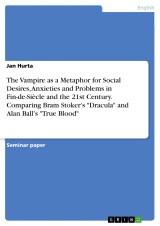Details

The Vampire as a Metaphor for Social Desires, Anxieties and Problems in Fin-de-Siècle and the 21st Century. Comparing Bram Stoker's "Dracula" and Alan Ball's "True Blood"
1. Auflage
|
13,99 € |
|
| Verlag: | Grin Verlag |
| Format: | |
| Veröffentl.: | 16.10.2018 |
| ISBN/EAN: | 9783668818002 |
| Sprache: | englisch |
| Anzahl Seiten: | 14 |
Dieses eBook erhalten Sie ohne Kopierschutz.
Beschreibungen
Seminar paper from the year 2017 in the subject English Language and Literature Studies - Culture and Applied Geography, grade: 1,3, University of Bamberg (Institut für Anglistik), language: English, abstract: With Dracula, Bram Stoker has created one of the biggest icons of modern literature. The ground-breaking novel has never been out of print since its release in 1897, and it introduced the figure of the vampire into the literary canon and also to millions of readers. From the beginning, the evil Count was read — by scholars as well as the ordinary audience — not only as a frightening monster but as a metaphor for the deeply conservative, moralistic and patriarchal Western and Victorian society of nineteenth century Britain. After a while of tranquility in terms of the vampire being a social phenomenon, it has regained its relevance since the end of the twentieth century by reaching a new peak of popularity, that lasts until today: books such as The Historian and The Twilight saga, movies such as the different film adaptations of Dracula and Interview with a Vampire and TV-shows such as The Vampire Diaries and the more mature True Blood show that the notion of the villain with the fangs enjoys much resonance amongst almost all age groups. This brings up the question whether the vampire and its central characteristics still are a suitable metaphor and embodiment for repressed desires, passions and issues of today’s globalized and secular Western society, as it was the case with the original Count Dracula from 1897. This essay aims at giving an answer to the question whether the traditional role, idea and utilization of the vampire character established as an expression of the latent social problems, fears and developments are still applicable today, and how the depiction of the vampire and especially the issues which it indicates have changed in today’s world. This will be done by by comparing Bram Stoker’s Dracula with Alan Ball’s show True Blood. Due to the limited extent of this essay, the focus will be concentrated on two aspects that are, nevertheless, significant and ostensive: one the one hand, the origin of the vampire and the particular setting of the plot; on the other hand, the vampire’s depiction, its powers and the crucial role of the blood. By that, this essays hopes to show — with a focus on Dracula — that the vampire is still an important metaphor, valve and symbol for contemporary ambitions, disputes and affairs just as it was over a hundred years ago for Victorian society.
Diese Produkte könnten Sie auch interessieren:

Politeness in Shakespeare: Applying Brown and Levinson´s politeness theory to Shakespeare's comedies

von: Abdelaziz Bouchara

43,00 €















